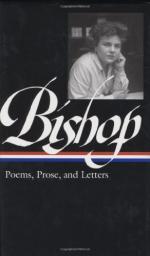|
This section contains 698 words (approx. 3 pages at 300 words per page) |

|
“Bishop's Casabianca,” in The Explicator, Vol. 52, No. 2, Winter, 1994, pp. 109-111.
In the following essay, Xiaojing examines “Casabianca” as a revision of other texts.
Love's the boy stood on the burning deck trying to recite ‘The boy stood on the burning deck.’ Love's the son stood stammering elocution while the poor ship in flames went down.
Love's the obstinate boy, the ship, even the swimming sailors, who would like a schoolroom platform, too, or an excuse to stay on deck. And love's the burning boy.
—Elizabeth Bishop
Elizabeth Bishop's “Casabianca,”1 seemingly simple, is one of her early poems that engages in a dialogue, incorporating images and utterances from another poem to redefine love. It is a response to the point of view of the poem that it alludes to. The meaning and complexity of “Casabianca” cannot be fully understood or appreciated without knowing what Bishop accomplishes by its intertextual...
|
This section contains 698 words (approx. 3 pages at 300 words per page) |

|


